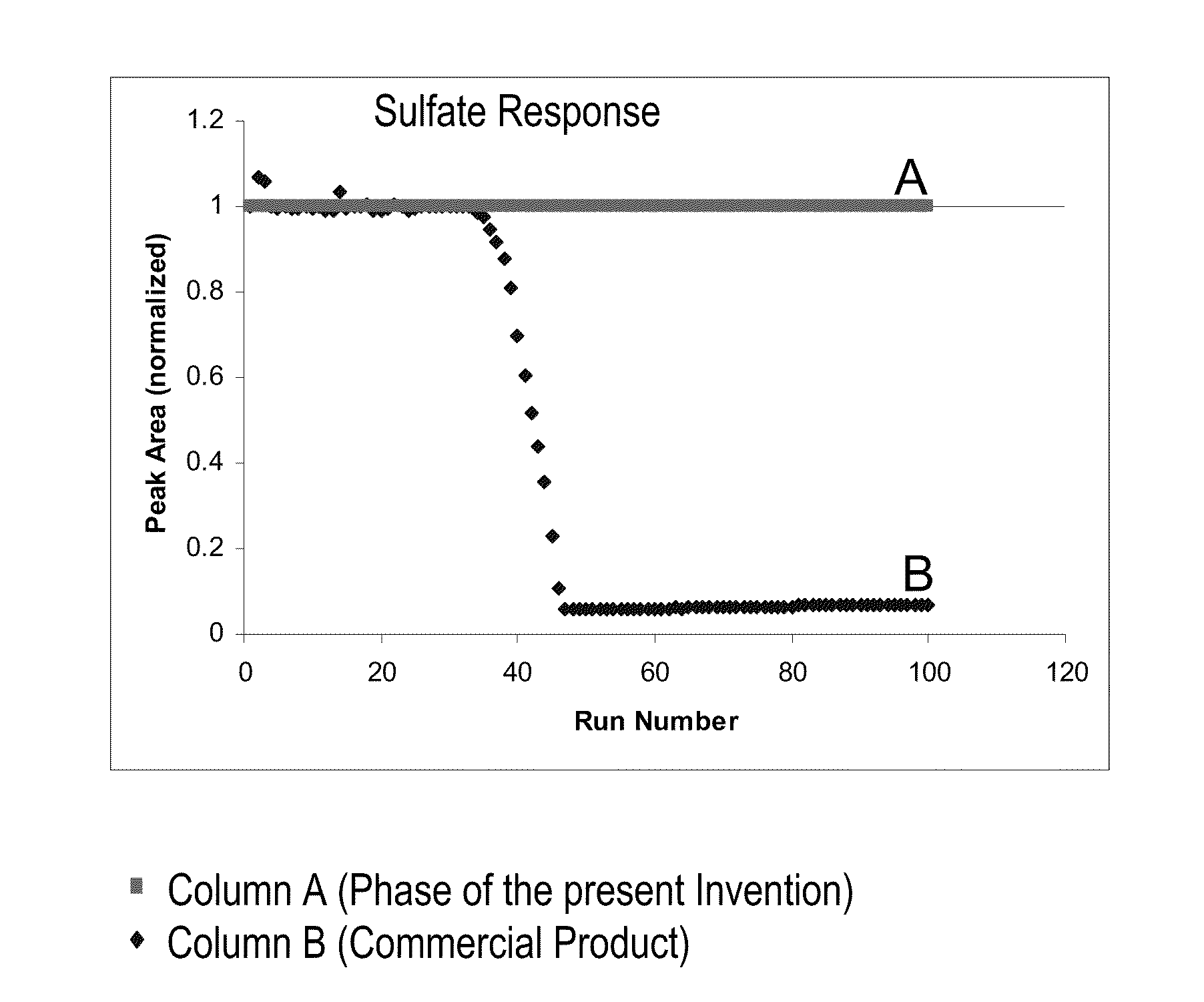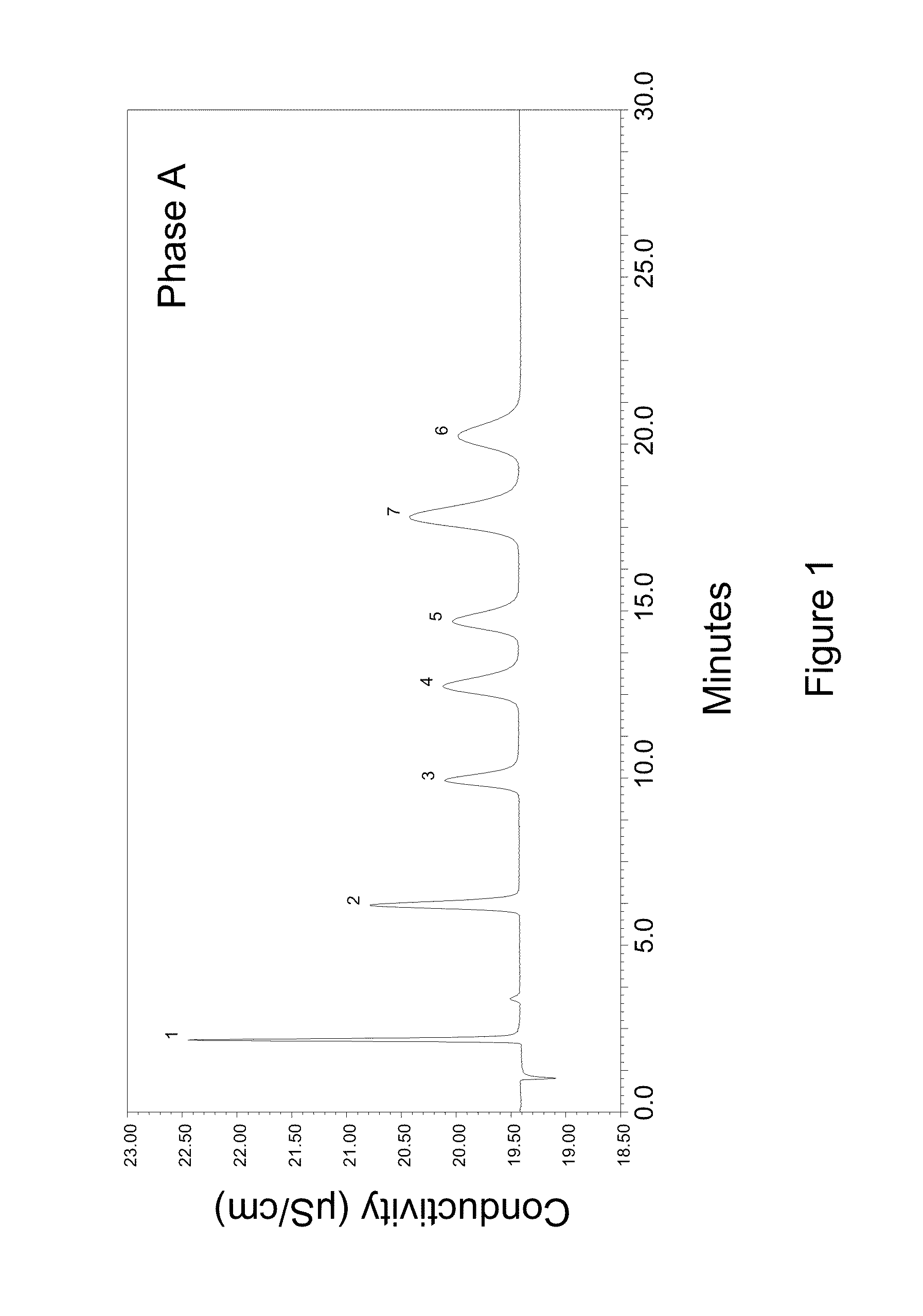High capacity ion chromatography stationary phases and method of forming
a technology of ion chromatography and stationary phase, which is applied in the direction of chromatographic cation exchangers, ion exchangers, separation processes, etc., can solve the problems of increasing manufacturing time and labor, taking a substantial period of time, and optimizing the packed column, so as to achieve excellent bromate resolution and excellent bromide resolution , the effect of optimal selectivity
- Summary
- Abstract
- Description
- Claims
- Application Information
AI Technical Summary
Benefits of technology
Problems solved by technology
Method used
Image
Examples
example 1
[0124]This example shows the synthesis of an organic layer on top of a chromatography substrate packing. Typically a polyvinyl benzene based polymer that is cross linked with divinyl benzene (55%) is used as the substrate resin. The process is as follows, 100 g of the substrate packing material was first dispersed in 50% IPA in Deionized (DI) water solution. The resin was submerged in the solution and mixed well. The resin was then rinsed twice with DI water and then filtered to a moist cake. The moist cake is dispersed in 200 g of DI water and then the monomer (A) and Initiator (B) was added. A) was comprised of a 10% to 20% monomer (Acrylic acid) in 200 gm of DI water and then 100 g of IPA solvent was added to the reaction mixture. The resin was mixed well. B) was comprised of 6 g of initiator (azobiscyanovaleric acid) which was added to a mixture of 30 g of DI water and 20 g of base (50% NaOH). The mixture was sonicated before adding this to the resin monomer mixture. The synthes...
example 2
[0125]For comparison purposes the substrate resin from Example 1 was also sulfonated. This procedure was designed to follow U.S. Pat. No. 7,291,395. The sulfonation procedure was as follows. A 1:5 ratio of resin to acetic acid (w / w) slurry was prepared first. Sulfuric acid was added to this mixture at a ratio of 1:20 (w / w) of resin to sulfuric acid. The mixture was stirred well and sulfonation proceeded at a) room temperature for 1 hour and at b) 4 hours at 50° C. The reaction was quenched by adding the resin mixture to a DI water reservoir of 1:10 resin mixture to DI water (w / w) ratio. The resin was filtered and washed with base and then with 20% methanol with a DI water rinse added in between these steps.
example 3
[0126]The resin from example 1 and 2 were next reacted following an amine epoxide chemistry as illustrated below. This was an in-column synthesis process and the resin was first packed into a 9×250 mm column by making a slurry in DI water and then packing this using DI water at a packing pressure of 4000 psi for 10 minutes. Next a chromatographic pump with a gradient proportioning valve was used for this work. The proportioning valve was connected to three solutions as listed below:
[0127]E1: 9.8% 1,4-Butanediol diglycidyl ether (BDDGE)
[0128]E2: 4.1% Methyl amine
[0129]E3: DI water
[0130]The solutions were proportioned as outlined below and pumped into the packed column from above (9×250 mm) and using a flow rate of 3 ml / min. The column was placed in a water bath at 60° C.
% E1% E2 % E3Comments72280Ground layer for 60 minutes10000Diepoxide layer for 35 minutes.0100 0 Methyl amine layer for 35 minutes———Repeat the diepoxide and amine layertwo more times.00100DI water rinse for 30 minutes...
PUM
| Property | Measurement | Unit |
|---|---|---|
| Time | aaaaa | aaaaa |
| Flow rate | aaaaa | aaaaa |
| Electric charge | aaaaa | aaaaa |
Abstract
Description
Claims
Application Information
 Login to View More
Login to View More - R&D
- Intellectual Property
- Life Sciences
- Materials
- Tech Scout
- Unparalleled Data Quality
- Higher Quality Content
- 60% Fewer Hallucinations
Browse by: Latest US Patents, China's latest patents, Technical Efficacy Thesaurus, Application Domain, Technology Topic, Popular Technical Reports.
© 2025 PatSnap. All rights reserved.Legal|Privacy policy|Modern Slavery Act Transparency Statement|Sitemap|About US| Contact US: help@patsnap.com



